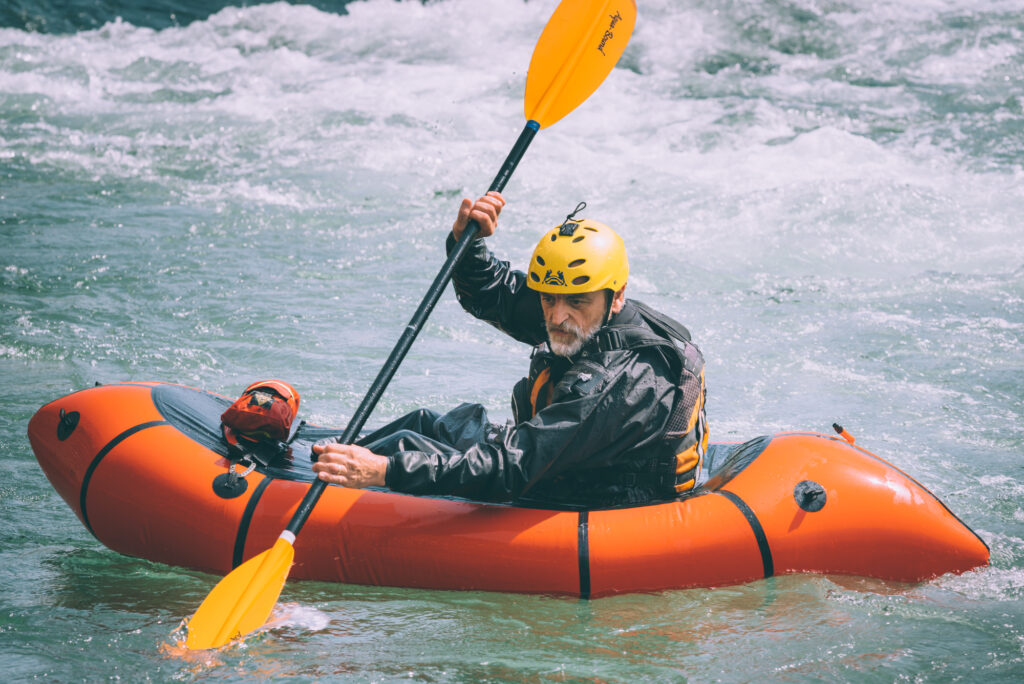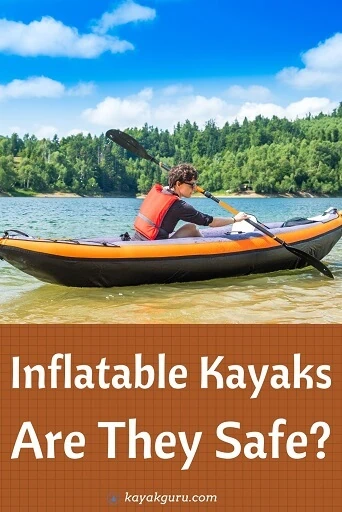
Do you love kayaking but are hesitant to invest in a traditional, bulky kayak? Have you considered trying out an inflatable kayak? You might be wondering, are inflatable kayaks safe? Well, let’s dive into that question and explore the world of inflatable kayaks together. In this article, we will discuss the safety of inflatable kayaks in detail, addressing common concerns and misconceptions. So sit back, relax, and get ready to learn more about the safety of inflatable kayaks!
Now, before we make any judgments, let’s consider the advantages and features of inflatable kayaks. First and foremost, inflatable kayaks are incredibly versatile and convenient. They can be easily inflated and deflated, allowing for easy transport and storage. This means you can take your kayak on all your adventures, whether it’s to remote lakes, rivers, or even on backpacking trips! Additionally, inflatable kayaks are often made from durable materials that can withstand harsh conditions. With advanced technology and design improvements, they are now becoming increasingly stable and sturdy. So, to answer the burning question, inflatable kayaks can indeed be a safe and reliable option for water enthusiasts. In the following sections, we will delve into the specifics, discussing the materials, construction, and safety features that contribute to the overall safety of inflatable kayaks. Stay tuned!
Introduction of inflatable kayaks
In recent years, inflatable kayaks have gained popularity among water enthusiasts. These versatile vessels offer a convenient and portable option for enjoying various water activities such as recreational paddling and fishing. However, you might wonder, are inflatable kayaks safe? In this article, we will explore the safety features and benefits of inflatable kayaks, debunk common misconceptions, and provide expert opinions and user experiences to help you make an informed decision.
Definition of inflatable kayaks
Inflatable kayaks are lightweight watercraft that can be inflated and deflated for easy transport and storage. Unlike traditional hard-shell kayaks, inflatable kayaks are made from durable materials such as PVC, Hypalon, or polyurethane, which provide flexibility and resistance to punctures. These kayaks consist of multiple air chambers that allow for increased buoyancy and stability, and they often feature safety grab lines and handles for easy maneuverability and rescue.

Types of inflatable kayaks
There are various types of inflatable kayaks available in the market, each designed for specific purposes and water conditions. Recreational inflatable kayaks are perfect for calm lakes and slow-moving rivers, offering stability and ease of use for beginners. Whitewater inflatable kayaks, on the other hand, are specifically built to withstand the challenges of rapid and turbulent waters, providing maneuverability and resilience. Additionally, there are inflatable kayaks designed for fishing, with features such as built-in rod holders and storage compartments.
Safety features of inflatable kayaks
Durable materials used in construction
Contrary to popular belief, modern inflatable kayaks are constructed using high-quality materials that are resistant to tears and abrasions. Manufacturers use reinforced PVC, Hypalon, or polyurethane to ensure the durability of the kayak. These materials are tough enough to withstand encounters with rocks, branches, and other obstacles that may be present on the water.
Multiple air chambers for added safety
One remarkable safety feature of inflatable kayaks is the presence of multiple air chambers. These chambers are separated by internal baffles, which means that even if one chamber gets punctured, the other compartments will remain inflated, providing buoyancy and keeping you afloat. This feature greatly reduces the risk of sinking or being stranded in the water.
Buoyancy and stability
Inflatable kayaks are designed to provide excellent buoyancy and stability. The combination of the kayak’s shape and the air-filled chambers helps it stay afloat and maintain balance even in rough waters. This stability makes it easier for beginners to paddle and reduces the likelihood of tipping over.
Self-bailing feature
Some inflatable kayaks come with a self-bailing feature, which allows water that enters the kayak to drain out through small holes or valves. This feature is particularly useful in whitewater kayaking, where waves and splashes are more likely to fill the kayak with water. By keeping the kayak clear of excess water, the self-bailing feature improves safety and prevents the kayak from becoming too heavy.
Safety grab lines and handles
To ensure easy maneuverability and rescue, inflatable kayaks often come equipped with safety grab lines and handles. These grab lines are usually located on the sides or front of the kayak and provide a secure grip for pulling yourself back into the kayak or for helping others in need. The handles are strategically placed for easy carrying and launching, making it convenient and safe to transport the kayak to and from the water.

Inflation and assembly process
Choosing the right pump
Before using an inflatable kayak, it is important to choose the right pump for inflation. Some kayaks come with their own hand pump, while others may require a separate electric pump for faster inflation. It is crucial to follow the manufacturer’s instructions and inflate the kayak to the recommended pressure to ensure maximum safety and performance.
Step-by-step inflation guide
To properly inflate your kayak, start by unrolling it on a clean and flat surface, avoiding any sharp objects or debris that could potentially puncture the material. Attach the pump to the kayak’s inflation valves and begin pumping air into the chambers. It is essential to inflate each chamber evenly, ensuring that they are firm and have no visible wrinkles or creases. Once the kayak is fully inflated, secure the valves tightly to prevent any air leakage.
Assembling the kayak components
After inflating the kayak, it is time to assemble the various components such as the seats and footrests. Many inflatable kayaks offer adjustable seats and footrests to provide a comfortable and customized paddling experience. Make sure to secure these components tightly to prevent any movement or instability during your kayaking adventure.
Maintenance and care
Cleaning and drying after use
Proper maintenance and care are essential to prolong the lifespan of your inflatable kayak. After each use, thoroughly rinse the kayak with clean water to remove any salt, sand, or debris that may have accumulated. Use a mild soap or kayak-specific cleaner to clean the surface and remove any stains. Once cleaned, allow the kayak to dry completely before deflating and storing it.
Proper storage to prevent damage
When it comes to storing your inflatable kayak, it is important to keep it in a dry and cool place, away from direct sunlight and extreme temperatures. Folding the kayak neatly and storing it in a bag or a designated storage container will protect it from potential damage and help maintain its shape.
Regular inspections and repairs
Regularly inspect your inflatable kayak for any signs of wear and tear, such as small punctures, leaks, or loose seams. It is crucial to repair any damages promptly to ensure the kayak’s structural integrity and safety. Most inflatable kayaks come with a repair kit that includes patches and adhesive, making it easy to fix minor issues. For major repairs, it is advisable to consult a professional or contact the manufacturer for assistance.
Protecting against UV rays and harsh weather conditions
UV rays can cause discoloration and deterioration of the kayak’s material over time. To protect your inflatable kayak from harmful UV rays, consider using a UV protectant spray or covering it with a kayak-specific cover when not in use. Additionally, if you plan to store the kayak outdoors for an extended period, make sure to secure it against strong winds and inclement weather.

Benefits of inflatable kayaks
Portability and ease of transportation
One of the major advantages of inflatable kayaks is their portability. When deflated and folded, they can easily fit into a compact bag, making it convenient to transport them in a car trunk or store them at home. This portability allows you to explore various bodies of water and take your kayak on vacations or outdoor adventures.
Compact storage
Unlike hard-shell kayaks that require ample space for storage, inflatable kayaks can be stored in small apartments or closets. Their deflated and folded form allows you to maximize storage space and avoid the hassle of finding a dedicated area for kayak storage.
Versatility for various water conditions
Inflatable kayaks are designed to perform well in different water conditions, from calm lakes and lazy rivers to choppy waters and whitewater rapids. The stability and maneuverability of these kayaks make them suitable for a wide range of water activities, including recreational paddling, fishing, and whitewater rafting.
Affordability compared to traditional kayaks
Inflatable kayaks are generally more affordable than their hard-shell counterparts. Traditional kayaks can be quite expensive, especially if you factor in additional costs for storage and transportation. Inflatable kayaks offer a cost-effective alternative without compromising on safety and functionality.
User-friendly for beginners
If you are new to kayaking, inflatable kayaks can provide a great starting point. Their stability, ease of use, and forgiving nature make them ideal for beginners who are still developing their paddling skills. Inflatable kayaks allow you to build confidence and enjoy the water without feeling overwhelmed.
Suitable for recreational activities and fishing
Whether you are looking for a relaxing day on the water or an exciting fishing adventure, inflatable kayaks are a great option. These kayaks often come equipped with features such as built-in rod holders, storage compartments, and even attachment points for adding additional accessories. Their versatility makes them suitable for recreational activities and provides a platform for avid anglers to enjoy their favorite hobby.
Factors to consider for safe kayaking
Proper fitting and wearing of life jacket
A properly fitted and worn life jacket is essential for safe kayaking. Regardless of your swimming abilities, it is crucial to always wear a Coast Guard-approved life jacket when on the water. Ensure that the life jacket fits snugly and comfortably, and that all straps are properly secured.
Being aware of weather conditions
Before setting out on your kayaking adventure, always check the weather forecast and be aware of any potential hazards. Thunderstorms, strong winds, and rough waters can present risks, especially for inflatable kayaks. Avoid kayaking in severe weather conditions and be prepared to adjust your plans accordingly.
Paddling techniques and skill development
To ensure a safe and enjoyable kayaking experience, it is important to learn and practice proper paddling techniques. Learning how to hold the paddle correctly, using efficient stroke techniques, and understanding proper body positioning will enhance your control and maneuverability on the water. Consider taking kayaking lessons or joining a local paddling club to develop your skills and gain confidence.
Avoiding risky maneuvers and obstacles
When kayaking, it is crucial to avoid risky maneuvers and potential obstacles that may lead to accidents or capsizing. Stay away from areas with strong currents, submerged rocks, or low-hanging branches. Maintain a safe distance from motorized boats, buoys, and other watercraft to prevent collisions. A cautious approach will greatly reduce the risk of accidents.
Carrying essential safety equipment
Always carry essential safety equipment on your kayaking trips. This includes a whistle or signaling device, a waterproof flashlight, a first aid kit, and a bilge pump or sponge for removing excess water from the kayak. Additionally, consider bringing a spare paddle, a rescue sling, and a repair kit in case of emergencies.

Common misconceptions about inflatable kayaks
Perception of low durability
One common misconception about inflatable kayaks is that they are not as durable as hard-shell kayaks. However, advancements in materials and engineering have greatly improved the durability of inflatable kayaks. They are now constructed using high-quality materials that are resistant to tears and punctures, allowing them to withstand rough waters and encounters with obstacles.
Belief that they are prone to punctures
Another misconception is the notion that inflatable kayaks are prone to punctures. While it is true that they are not indestructible, most inflatable kayaks are designed to be highly resistant to punctures. As mentioned earlier, modern materials used in their construction, such as reinforced PVC or Hypalon, provide durability and puncture resistance. By avoiding sharp objects and practicing basic kayak care, the risk of punctures can be minimized.
Assumption of poor performance in rough waters
Some may assume that inflatable kayaks perform poorly in rough waters. However, inflatable kayaks, especially those specifically designed for whitewater or rough waters, are built to handle challenging conditions. They offer stability, maneuverability, and the ability to withstand waves and turbulent waters. Having multiple air chambers and reinforced construction enhances their ability to perform well even in adverse conditions.
Expert opinions and user experiences
To gain further insight into the safety and reliability of inflatable kayaks, let’s look at the opinions of experts and the experiences of users.
Reviews from experienced kayakers
Experienced kayakers who have used inflatable kayaks often praise their safety features, ease of use, and excellent performance. Many users particularly appreciate their buoyancy, stability, and ability to handle various water conditions. Reviews frequently mention the durability of modern inflatable kayaks and how they have exceeded expectations in terms of longevity and resistance to punctures.
Insights from professionals in the industry
Professionals in the paddling and water sports industry also acknowledge the safety and versatility of inflatable kayaks. Manufacturers and retailers emphasize the importance of proper maintenance and care to ensure the longevity and performance of inflatable kayaks. They offer tips and guidelines for inflation, assembly, and storage to help users make the most out of their kayaking experience.
Anecdotes of successful inflatable kayak adventures
Countless anecdotes from adventurers and outdoor enthusiasts attest to the safety and enjoyment provided by inflatable kayaks. Stories of memorable trips, successful whitewater expeditions, and relaxing fishing sessions showcase the versatility and reliability of these kayaks. From serene lakes to challenging rapids, inflatable kayaks have enabled individuals to explore and connect with nature in a safe and thrilling manner.

Comparisons with other types of kayaks
Inflatable vs. hard-shell kayaks
Comparing inflatable and hard-shell kayaks, there are pros and cons to each type. Inflatable kayaks offer advantages in terms of portability, ease of storage, and affordability. They are also more forgiving to beginners and offer excellent stability. Hard-shell kayaks, on the other hand, provide superior speed and tracking in the water. They are generally more durable but require more space for storage and transportation.
Inflatable vs. folding kayaks
Folding kayaks, similar to inflatable kayaks, offer portability and compact storage benefits. However, folding kayaks tend to be more complex to assemble and disassemble compared to inflatable kayaks. In terms of durability, both inflatable and folding kayaks use advanced materials to ensure longevity and resistance to punctures. The choice between the two types often comes down to personal preference and specific needs.
Inflatable vs. sit-on-top kayaks
Sit-on-top kayaks are another popular option for water activities. While they provide an open design and easy entry/exit, they are generally heavier and bulkier compared to inflatable kayaks. Inflatable kayaks offer more versatility, as they can be used for various purposes such as fishing, recreational paddling, and whitewater adventures. In terms of safety, both types can provide a secure and enjoyable experience when used correctly.
Conclusion
Inflatable kayaks are indeed a safe and reliable option for water enthusiasts of all skill levels. With advancements in materials and engineering, these kayaks offer durability, stability, and excellent performance in various water conditions. The presence of multiple air chambers, safety grab lines, and buoyancy features ensures added safety and peace of mind.
By following safety guidelines, investing in proper maintenance, and choosing the right kayak for your needs, you can have a safe and enjoyable kayaking experience. The portability, affordability, and user-friendly nature of inflatable kayaks make them a fantastic choice for recreational activities, fishing, and even adventures in rough waters.
So the next time you are out on the water, whether it be exploring serene lakes, conquering challenging rapids, or enjoying a leisurely fishing trip, you can confidently say, “Yes, inflatable kayaks are safe!”







